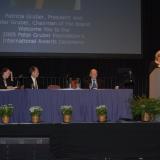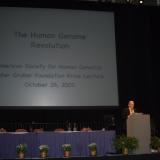2005 Gruber Genetics Prize
A pioneer in the field of genomics, Dr. Robert H. Waterston played a pivotal role in the Human Genome Project both as a scientist, with his work on large-scale DNA sequencing, and as an advocate for free public access to the genomic information.
2005 Genetics Prize Recipient
Laureate Profile
Robert Waterston is distinguished for numerous powerful contributions to genetics. He pioneered the molecular genetic analysis of muscle structure, function and assembly in C. elegans, personally identifying many of the genes involved. He discovered and analyzed the first tRNA suppressors to be found in C. elegans, or indeed in any multicellular organism.
He was one of the fathers of genomics. Together with John Sulston he mapped and then sequenced the genome of C. elegans – the first multicellular organism in which this task was accomplished.
In the public sequencing of the human genome he not only carried out much of the work but also was the central coordinator, constructing the physical map that formed the framework for the enterprise. Earlier he had released a very large set of human and other cDNA sequences for public use.
His influence was critical in the free release of genomic information, without which many biologists would be unable to access this fundamental data. Most recently, he has led on sequencing of mouse, C. briggsae, and chimpanzee, the finishing of the human genome, and the human SNP map.
Citation
The Genetics Prize of The Peter Gruber Foundation is hereby proudly presented to Robert Hugh Waterston, M.D., Ph.D., a pioneer in the field of genomics.
By mapping and then helping determine the sequences of the genomes of the nematode Caenorhabditis elegans and the human, Waterston played a pivotal role in the Human Genome Project.
He conceptualized and executed a broad variety of large-scale genomic investigations that made the fruits of genomic sequences immediately useful to all biological scientists.
His vigorous and instrumental advocacy of the importance of maintaining complete and free public access to genomic information has been critical for maximizing the use of such information to benefit humanity.














































